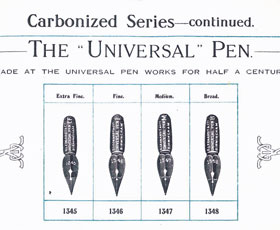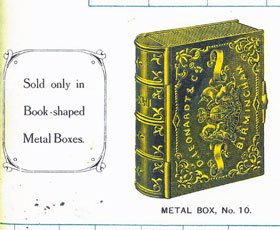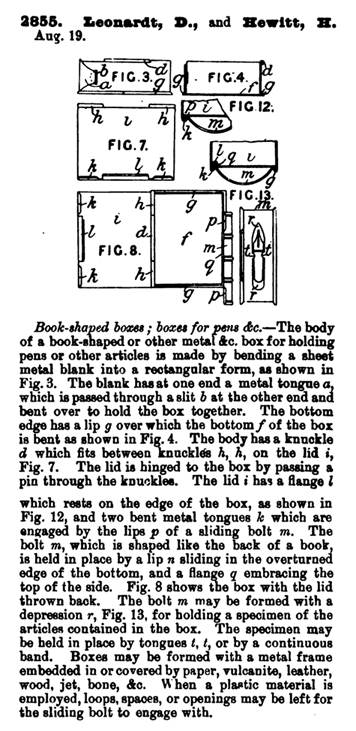Why the “Book” by D. Leonardt & Co. is not a Needle Case
The following narrative was original researched and written in 2011 and was published in the book My Avery Needle Case Collection
by Terry Meinke in April 2012. No changes have been made to this story other than dividing the text into sections to make it easier
for individuals to access the information they are interested in. The sections are:
Introduction
A Little Research
Contacting the Company
Summary
Addendum
Several years after writing this narrative I discovered one commercial directory from 1870 that listed D. Leonardt & Co. as a needle case manufacturer. As a result, I searched through dozens of other trade and business directories and was unable to find another instance where this company was listed as anything other than a pen company. In addition, I searched records at the UK National Archives and the British Library Business and Intellectual Property Centre and no patents or designs for needle cases were registered to D. Leonardt & Co. Even if the company did in fact manufacture needle cases at one point, there is no evidence to suggest they designed or patented any needle cases.


Introduction
Many consider the book entitled “Victorian Brass Needlecases” as the bible for Avery needle case collectors. Published in 1990 by Ruth Mann and Estelle Horowitz, the book represents outstanding work researching and documenting needle cases. My analysis, however, suggests that they misclassified a brass box made by D. Leonardt & Co., which they named the “Book”.
In the late 1990's my brother Drake, who lived in Germany at the time, found a “Book” at a flea market in France and gave it to me as a gift. It had an interesting coat of arms pattern with the phrase, “D. Leonardt & Co’s Birmingham”, embossed on the cover. The brass differed slightly in color and texture from the other needle cases in my collection, however, and it was the only flat-style needle case I owned that lacked the usual numbered compartments for the different sized needle packets. The sides and bottom had little or no decoration other than lines which resembled the pages of a book, while on the Book’s ‘spine’ one could see a small pointed oval-shaped indentation and the words “Vol III”. After examining it carefully, I sensed that something was missing, something that would fit into that indentation. But what could it be? Because this brass box was pictured and described in Mann’s book I automatically assumed it to be a needle case. A few years later Drake found me another “Book” in France. Identical in shape to the first, this “Book” was stamped “Vol IIII” on the spine, while the bottom was embossed with a repetitive pattern that contained the words “Universal Pen”. The first had been empty, but this one contained old pen tips, the kind I remember seeing in my grandmother’s antique shop when I was a child. Since the two cases were practically identical, I carelessly discarded the pen tips, kept the case that was in the best condition and sold the other on eBay. As I placed it on the shelf in my display case, however, I couldn’t help but wonder, was this really a needle case?


A Little Research
I gave it little thought until April 2011 when I started to photograph the flat needle cases in my collection. To pass the time one evening I decided to Google all of the manufacturers whose names were inscribed on my cases to see if any of them were still in business. The only one I could find was D. Leonardt & Co whose main product, according to their website, was pen nibs. Several days later, I discovered the Birmingham Postal Directories and other trade directories from the 1850's through 1910's online. These directories listed D. Leonardt & Co. only under trades related to the pen and pen-accessories industry: pen holder, pencil holder and steel pen manufacturing. The directories contained separate listings for die sink makers, gilt jewelry manufacturers, needle manufacturers, needle case manufacturers and patent agents which included many of the names engraved on my other needle cases or from the patents mentioned in Mann’s book. Because Leonardt was never listed under these trades, I concluded that the company was not a needle case manufacturer. Interestingly, one postal directory listed Leonardt as having a depot at St. Denis in Paris, France, which would explain why the two cases mentioned above found their way to France and why they both contained the words “Brevete S.G.D.G” on the front, which indicated an item was manufactured for export to France. Weeks later I discovered the company had a booth at the Paris Universal Exhibition of 1889, which was described in the exhibition catalogue as “D. Leonardt & Co. Universal Pen Works, Birmingham. Steel pens of all descriptions for all countries”.
I found confirming evidence regarding the company’s trade at the ‘Made in Birmingham - Birmingham’s Industrial History’ website. It contained an interesting nine-page article on the history of the Birmingham pen industry. D. Leonardt & Co. was one of the area’s fourteen major pen makers, founded in 1856 and most noted historically for its patented nibs with hemispherical tips. In 1949 the company moved about 30 miles west to Highley in Shropshire where it still manufactures pen nibs and fountain pens today.
Perhaps my “Book” was not a needle case after all? I still needed more proof, however. Finding the original patent, would be the proof I was seeking. The patent number was not listed in Mann’s book; however the patent date was--April 17, 1872. With that information I contacted the London researcher I’d hired to check design registrations at the UK Archives and asked him to see what he could find. A few days later he informed me that although he had searched from January through August of 1872, D. Leonardt had not registered any designs during that period; however, W. Avery and Son had registered a design on April 17, 1872, entitled the “Bombe”. Mann’s index was in alphabetic order, and the “Book” was listed directly under the “Bombe”. Mann’s indexers had made a common error when transcribing their notes into printed format! There was no need to research the patent date Mann provided for the “Bombe” because it was within the time period already considered.


Contacting the Company
Because the company was still in business, I wrote to ask if they could provide any additional information about the “Book” in my collection. I enclosed five detailed photographs in my letter to their Shropshire address. Less than two weeks later I received the following reply via email from Nick Stockbridge, the Chairman and Managing Director of Manuscript Pen Company Ltd.:
D. Leonardt & Co Ltd ceased trading as an independent company about 4 years ago but the name belongs to my Company, Manuscript, which still produces a range of D. Leonardt & Co nibs. The original Company D. Leonardt & Co Ltd., however has been owned by my wife’s family and myself since 1949. My son is the 5th generation involved in making nibs going back to the 1850's! Your photos are of a box that was used latterly for selling a particular range of pen nibs, The Universal Range. I have attached a page from an old Leonardt Sales Catalogue. I still have limited stock of these tins!
Technically they were called “Metallic Boxes” and the original patent goes back to pre-1866. The confusion concerning needles is that at one stage patents were granted to Hezekiah Hewitt for Metallic Boxes for Holding Steel Pens, Pins, Needles, and other Small Articles.
Whilst I believe that tins of this nature were used generally in the second half of the 1800's by pen nib makers (there are various other examples – see Air France menu cover), they were replaced by cheaper paper based boxes.
Depending on the style of nib, they would have been capable of holding up to a gross (144) of nibs and the depression section of the spine of the box would have held an example of the nib model inside the box.
The two attachments to Mr. Stockbridge’s email contained additional information about the “Book”. The sales catalogue page entitled “The Universal Pen” included illustrations of the four types of nibs available: extra fine, fine, medium and broad, as well as the information that they were only sold in book-shaped metal boxes. The center of the page contained a photograph of a box that looked exactly like my “Book”. Another photograph of pen cases graced the cover of the Air France menu, these from the collection of Lionel Van Cleem, including four “Books” volumes I, II, III and IIII. A note on the back described them as gilt brass nib boxes from 1850 to 1890. “These book-shaped boxes with the D. Leonardt trademark, sold in France, have etched page-like lines used for striking matches after the nibs were finished”. Upon reading this I immediately ran to my display case, pulled out the “Book” and tried to light a match. It worked!


Summary
Manufacturers created needle cases and pen nib boxes not for their own sake but in order to sell something else. Numerous needle and pen manufacturers in the Birmingham area competed to sell their products and to increase sales, a manufacturer needed to be creative in finding ways to entice consumers to prefer its product over that of others. Needle cases not only held needles but also appealed to women. Because middle class Victorian women spent considerable time stitching during the day, they needed not only a place to store their needles but also something that would look decorative sitting on the table when other ladies dropped in for visits. As a result, W. Avery & Son created fancy, whimsical brass needle cases. By contrast pen nib manufacturers needed a small container that could hold a quantity of nibs and also provide the customer with a way to easily choose the correct size. D. Leonardt & Co.’s book-shaped brass box, that displayed a sample nib on the spine, cleverly accomplished this task. Leonardt added an additional feature that gave their receptacle a further use once empty--it could hold matches and serve as a match striker. Its size and usefulness appealed to Victorian men and women alike, for the “Book” could easily fit into a pocket, sit on a desk or be stored in a drawer. Its attractive decoration ensured the nib box was not simply thrown away.
After further correspondence with Stockbridge, I developed an appreciation for pen nibs, something I barely knew existed before I started this research. I regretted so carelessly throwing away those pen nibs all those years ago. The brief history of the pen industry Stockbridge had provided inspired me to seek additional information from Wikipedia. I wondered, where would we be if the pen had never been invented? What about all those years of human history when people used only quill pens and few were able to write? Imagine William Shakespeare in 1609 writing each page of his impressive sonnets by hand with a quill pen. The metal pen nib first mass produced in Birmingham in 1822 was a gift from the Industrial Revolution that helped transform the world from illiterate masses to educated citizens. From quill and ink, to pen and ink, to ball point pen and, today in the Information Age, the word processor, the technology of writing has hugely advanced. Each invention provided a stepping stone allowing greater numbers of people to more easily express themselves. And new technologies are arriving every day. Soon we’ll be able to speak directly into a device that will automatically translate our voices into a print format and with the push of a bottom or the touch of a screen will translate it into a thousand different languages. The history of the pen is as fascinating as the history of the needle.
Without needles and pens, needle cases or pen nib boxes would never have existed for us to collect. It isn’t every day that we learn something new, something that gives us a new appreciation for the simplest of things. For this I am indebted to Mr. Stockbridge. My “Book” pen nib container holds its rightful place in the display case next to my needle cases. After all, who knows who originally purchased those nibs? It had to be someone in France, perhaps Gustave Eiffel himself!
Addendum
In November 2014 Patent #2855 for a book shaped box for pens patented on August 19, 1874 to D. Leonardt and H. Hewitt was found which appears to cover the design for this item.





